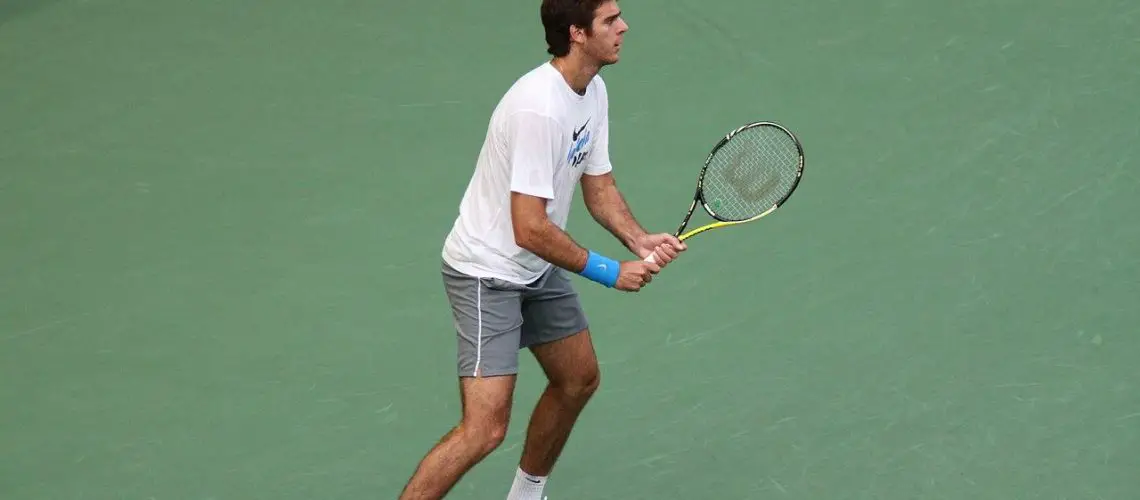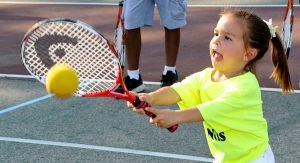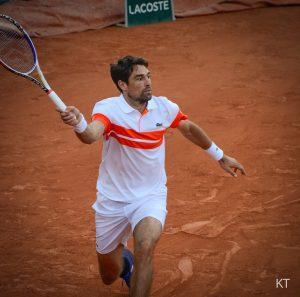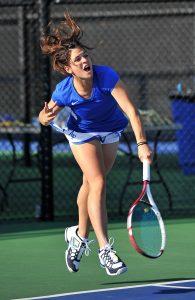We may earn money or products from the companies mentioned in this post.
Introduction to Top Spin in Tennis

Tennis is a sport that demands skill, strategy, and finesse One of the most crucial techniques in tennis is the ability to generate top spin on the ball Top spin refers to the rotational motion imparted on the ball, causing it to dip and bounce unpredictably upon landing Understanding and mastering this technique can significantly enhance a player’s game
Definition and Basic Concept of Top Spin
In simple terms, top spin is a type of spin applied to the ball by brushing upward against its surface with an angled racket face This action creates a forward rotation on the ball, making it rotate from top to bottom as it travels through the air
Compared to other types of spins such as backspin or sidespin, top spin has unique characteristics that set it apart While backspin causes the ball to float and skid upon landing, and sidespin alters its trajectory sideways, top spin adds depth and bounce to shots
Brief History and Evolution of Top Spin Technique
The origins of top spin can be traced back to early tennis players who experimented with different ways to control their shots However, it was during the 1970s that this technique gained widespread recognition thanks to several notable players who popularized its use
One such player was Bjorn Borg, a Swedish tennis legend known for his powerful groundstrokes with heavy top spin Borg’s success revolutionized how players approached their shots, emphasizing topspin as an essential element of modern tennis
Another influential figure in popularizing top spin was Rafael Nadal The Spanish maestro took advantage of his physicality and perfected an aggressive topspin style that helped him dominate clay court surfaces His relentless use of heavy topspin allowed him to hit high-bouncing shots that troubled opponents
Since then, top spin has become a fundamental aspect of the game, employed by players at all levels to add power, control, and variation to their shots It has become an indispensable tool for players looking to gain an edge over their opponents
In conclusion, understanding and utilizing top spin in tennis can elevate a player’s performance and make their shots more unpredictable Whether you are a professional or an amateur player, mastering this technique can unlock new possibilities on the court
Mechanics and Physics behind Top Spin

The Role of Racket Angle, Grip, and Swing Path
When it comes to generating topspin, tennis players rely on a combination of racket angle, grip, and swing path The magic happens when the player strikes the ball with a slightly closed racket face, brushing upwards along its surface This brushing motion creates friction between the strings and the ball, causing it to spin forward while also moving in an upward direction
A player’s grip plays a crucial role in generating topspin as well By using a semi-western or western grip, which naturally positions the hand slightly to the right (for right-handed players), they can achieve more control over the racket angle during contact with the ball It allows for easier manipulation of the racket face to create that desirable spin
Furthermore, swing path also plays a significant role in topspin generation A more pronounced upward swing path encourages greater brush contact between the strings and the ball, resulting in increased topspin
Effects on Ball Trajectory, Bounce, and Player’s Advantage
Topspin has a profound impact on both ball trajectory and bounce characteristics When a player imparts topspin onto the ball during their stroke, it causes the ball to dip downwards more quickly after leaving their racket This downward trajectory is due to aerodynamic forces acting on the spinning ball
Upon contacting the court surface, a topspin shot tends to bite into it with enhanced grip This effect results from the forward rotation of the ball imparted by topspin As a result of this increased traction upon impact with the court surface, it makes it harder for opponents to handle such shots effectively
The benefits of utilizing topspin go beyond just controlling trajectory and bounce; they also provide players with a distinct advantage Topsin shots tend to clear the net more comfortably due to their dipping trajectory, reducing the risk of hitting it into the net Additionally, topspin allows players to generate greater power while maintaining control, making it an essential weapon in their arsenal
Mastering Top Spin Technique: Tips and Drills for Improvement

The right grip: Eastern forehand, Semi-Western, or Western grip?
When it comes to generating topspin on your shots, the grip you use plays a crucial role There are three main grips that players commonly use – Eastern forehand, Semi-Western, and Western grip
The Eastern forehand grip is the most traditional one and offers a good balance between control and power It allows you to generate moderate topspin while maintaining accuracy in your shots
The Semi-Western grip provides a slight variation by positioning your hand slightly further towards the back of the handle This allows for more natural topspin generation as the contact point shifts higher on the ball It is especially effective for players who want to add more spin to their shots without sacrificing too much control
The Western grip takes it a step further by positioning your hand even further towards the back of the handle This extreme grip allows for maximum topspin generation but can be challenging to master due to decreased control over shot placement
1 How do these grips impact topspin generation?
The different grips impact topspin generation by changing the angle at which you make contact with the ball The more extreme the grip, such as Semi-Western or Western, the higher up on the ball you will make contact, resulting in increased spin
With an Eastern forehand grip, you’ll have a flatter contact point that generates less spin but offers greater accuracy As you move towards a Semi-Western or Western grip, your contact point moves higher on the ball’s surface, allowing for increased topspin potential
2 Which one is best suited for individual playing styles?
The best grip for your playing style depends on various factors, including your physical attributes, strengths, and preferences If you prioritize control and accuracy over spin, the Eastern forehand grip might be the most suitable option for you
If you’re an aggressive player looking to add more spin to your shots while still maintaining a good level of control, the Semi-Western grip could be ideal On the other hand, if you’re a power player who wants maximum topspin potential at the expense of some control, experimenting with the Western grip might be worth considering
Practice drills to improve your topspin shots
To improve your topspin shots, incorporating specific practice drills into your training routine can make a significant difference These drills focus on developing better control and consistency in generating topspin:
1 What specific exercises can help develop better control over topspin shots?
a) Shadow swings: Stand in front of a mirror and practice your swing motion without hitting any balls Focus on proper technique and follow-through to ingrain muscle memory for generating topspin
b) Target practice: Set up targets or cones on the court and aim to consistently hit them with topspin shots Start with larger targets and gradually decrease their size as you improve
c) Controlled rally: Rally with a partner or against a wall while focusing on keeping the ball consistently above net height with ample topspin Gradually increase rally length and intensity as you become more comfortable
2 How should you incorporate these drills into your regular practice routine?
Incorporating these drills into your regular practice routine is key to improving your topspin technique effectively:
a) Allocate specific time: Dedicate a portion of each training session solely to working on topspin shots using these drills Consistency is crucial for progress
b) Gradual progression: Start with simpler drills and gradually increase the difficulty level as you improve This incremental approach allows you to build a solid foundation before moving on to more challenging exercises
c) Mix it up: Vary your practice routine by incorporating different drills each session This keeps your training engaging and prevents monotony, allowing you to focus on different aspects of topspin generation
By following these tips and incorporating targeted practice drills into your training routine, you’ll be well on your way to mastering the top spin technique in no time Remember, consistency and dedication are key to making significant improvements in your game
Common Challenges and Misconceptions about Top Spin

When it comes to tennis, the use of topspin is often surrounded by a cloud of myths and misconceptions Let’s debunk some of these common misunderstandings and shed light on the truth behind them
1 Is there such a thing as too much topspin?
Some players believe that using excessive topspin can be counterproductive, leading to shots that sit up nicely for opponents to attack However, this notion is not entirely accurate While it’s true that too much topspin can make the ball bounce higher, giving your opponent an opportunity to strike with more power, it also allows you to hit the ball with greater margin for error over the net So instead of fearing too much topspin, focus on mastering its control and harnessing its benefits
2 Does using more topspin necessarily mean sacrificing power or accuracy?
Another misconception about topspin is that increasing its usage will result in compromised power and accuracy In reality, generating spin doesn’t have to come at the expense of power or precision if executed correctly By brushing up on your technique and finding the right balance between racquet head speed and spin production, you can enjoy the best of both worlds – explosive shots with added control and consistency
Adapting to Different Court Surfaces & Opponents’ Styles

The effectiveness of your topspin shots can vary depending on court surfaces like clay, grass, or hard courts as well as your opponents’ playing styles Here are some tips on how to adapt in different scenarios:
1 How can you maximize the effectiveness of your topspin shots on various surfaces like clay, grass or hard courts?
– Clay Courts:
On clay, the slower surface allows for more time to generate topspin Take advantage of this by focusing on heavy topspin shots that bounce high and deep, making it difficult for your opponent to handle them effectively
– Grass Courts:
With faster ball speed and lower bounce on grass, you’ll need to adjust your topspin technique accordingly Aim for flatter shots with less spin to keep the ball low and skidding through the court
– Hard Courts:
Hard courts offer a balance between clay and grass surfaces Optimize your topspin shots by finding a middle ground – generating enough spin to control the ball’s trajectory while maintaining power and consistency
2 How should you adjust your strategy when facing opponents who are adept at handling topspin shots?
When coming up against opponents who excel at dealing with topspin shots, it’s crucial to mix up your game plan strategically Consider incorporating a variety of shot types such as slices, flat shots, or drop shots into your arsenal to disrupt their rhythm and keep them off balance By diversifying your shot selection and keeping them guessing, you can neutralize their ability to exploit your topspin
In conclusion, debunking the myths surrounding topspin and adapting to different court surfaces and opponents’ styles are essential aspects of mastering this influential tennis technique By understanding its nuances and applying effective strategies, you can elevate your game and become a formidable force on any court
Useful Links

Topspin Forehand I 5 Steps To Get More Topspin On Your …
Learn the Topspin Tennis Serve Technique
Why is Topspin Considered So Important in Tennis …
The Science of Spin
How to Hit a Top Spin Forehand for a Beginner – Tennis …
Topspin Pro Review – Learn to hit perfect Topspin
How To Hit a Topspin Shot in Tennis: 10 Steps
Flat, Spin, and Everything in Between
Topspin
Table Tennis/Spin – Wikibooks, open books for an open world
Top Spin Tennis Drills, Videos and Coaching Plans
Is topspin overrated in the modern game? : r/tennis
9 Proven Ways To Generate More Topspin In Your Tennis …
Topspin Tennis Academy
Top Spin Tennis: Sports Clothing | Rackets | Squash …
Simple Steps to get more Topspin on Your Groundstrokes
Top Spin Tennis
Topspin Tennis, San Francisco






